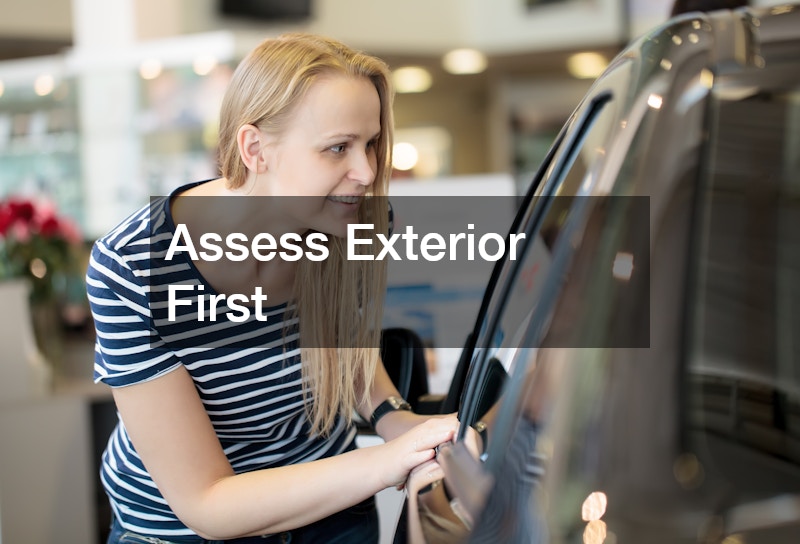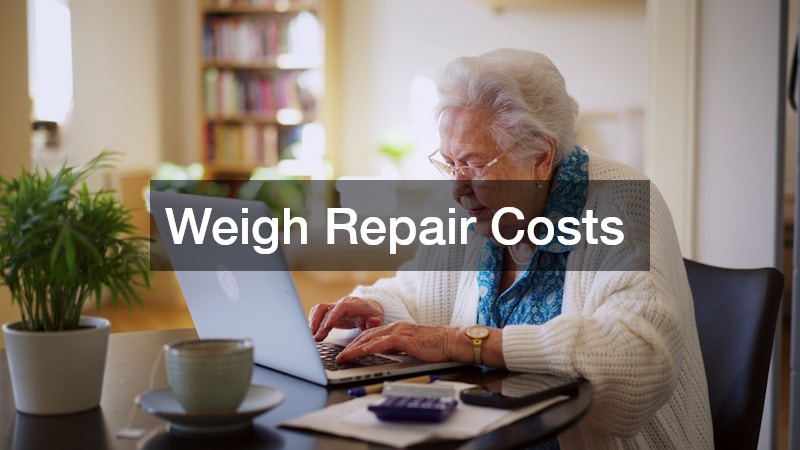When a storm rolls through and leaves behind dents or cracks on your car, the first instinct is often frustration or worry. Minor hail damage might look superficial at first, but even small blemishes can add up to bigger concerns if left unaddressed. From cosmetic flaws that reduce pride of ownership to hidden issues that may worsen over time, knowing what steps to take immediately after a hail event can make all the difference. The process isn’t just about fixing dents—it’s about ensuring your vehicle maintains safety, performance, and long-term value.
Understanding how to respond begins with a thorough inspection. Each part of your vehicle, from the exterior paint to the windows, requires a careful look. Some damage is obvious, like cracked glass, while other problems may only become noticeable after close examination. Once you’ve identified what’s been affected, the next step is to organize documentation, weigh potential repair costs, and research service providers. By moving through these steps systematically, you can save both time and money while reducing the risk of overlooking something important.
Beyond repairs, prevention and protection should be top priorities. After addressing immediate needs, it’s worth exploring options to protect your car from hail in the future. Modern protective products and professional services can extend the life of your vehicle and make it more resilient against unpredictable weather. Additionally, considering long-term care and ways to preserve resale value helps ensure that today’s storm doesn’t create tomorrow’s financial headache. Below are ten steps vehicle owners can take to effectively manage repairs and reduce potential insurance impacts moving forward.
1. Assess Exterior First

When a storm passes, the most immediate step is to examine your car’s exterior for dents, scratches, or dings that may have developed. A quick visual assessment can help you understand the overall impact and whether damage appears concentrated in one area or spread across multiple panels. While it may seem like just cosmetic flaws, exterior marks can have a compounding effect over time, leading to rust, reduced appeal, and possible compromises to protective finishes. Taking the time to carefully check the body right after a storm sets the foundation for the next steps.
During your inspection, look for signs that could eventually require professional car paint services. Even small cracks in the surface can let in moisture, which may corrode metal and create long-term issues. Minor hail damage often leaves shallow dents that may look harmless but can quickly add up to more extensive problems if left untreated. Identifying whether the paint has chipped or if dents are located in sensitive spots, such as near seams or edges, is key to determining urgency. It’s also important to know how big hail has to be to damage your car, as this can guide your assessment and insurance discussions.
It’s also wise to document what you see, noting the size, location, and appearance of every blemish. This record not only helps when speaking with repair professionals but also gives you peace of mind knowing you haven’t overlooked anything. By approaching the exterior review thoroughly, you’re less likely to miss potential problem areas and better prepared for conversations about repair strategies. Taking this careful first step ensures you begin the restoration process from a strong, organized position.
2. Inspect Windshield
Your vehicle’s glass is one of the most vulnerable components during a storm, and close inspection is crucial once the skies clear. Windshields, side windows, and rear glass panels are all susceptible to cracks, chips, or stress fractures. Left unattended, even the smallest imperfection can spread across the surface, weakening visibility and overall safety. By carefully checking each glass surface, you reduce the chance of overlooking hazards that could compromise your driving experience.
When examining your windshield, prioritize spotting chips or cracks that may require auto glass replacement or repair. Minor hail damage often strikes in scattered patterns, so it’s important to evaluate not just the obvious cracks but also any subtle impact points. A coin-sized chip might not seem urgent at first, but over time, vibrations from regular driving or temperature shifts can cause it to expand, creating a much bigger problem.
3. Review Hidden Areas

While dents and cracks on obvious surfaces are easy to notice, damage can also hide in areas that aren’t immediately visible. Checking less obvious spots—such as under door handles, along roof rails, or around trim—can reveal smaller marks that may otherwise escape your attention. Over time, these hidden flaws can become bigger problems, particularly if they allow water to seep into unprotected areas. A comprehensive review ensures no part of the vehicle is overlooked.
Specific areas like wheel wells, bumpers, and undercarriage parts may show signs of stress that connect directly to auto parts durability. Minor hail damage has a way of showing up in surprising places, and without a closer look, you may not realize the extent of the storm’s impact. By paying attention to parts that don’t typically draw your eye, you reduce the risk of long-term issues that can cause both inconvenience and expense.
4. Document Every Mark
After spotting dents, cracks, or scratches, your next step should be to create a clear record of what you’ve found. Thorough documentation ensures you have evidence for insurance claims, repair estimates, or resale discussions. By photographing each affected area from multiple angles, you create a reliable file that can be referred to later if questions arise. This step may feel tedious, but it serves as your safeguard against disputes.
When documenting, think about how each blemish might influence your car value. Even seemingly minor hail damage can reduce a buyer’s willingness to pay top price or an insurer’s willingness to cover repairs without detailed evidence. Photographs paired with written notes about the location, size, and depth of the damage make your case much stronger. Without these records, you may find yourself at a disadvantage when negotiating costs or compensation.
5. Weigh Repair Costs

Once you’ve cataloged the damage, it’s time to start thinking about repair costs. This step is critical for setting realistic expectations and making informed decisions. Some dents or chips may require quick fixes, while others could demand more significant attention. By reviewing estimates early, you avoid unwelcome surprises and plan your budget accordingly.
One way to approach this is by reaching out to an auto body repair shop for an evaluation. Experienced professionals can assess how minor hail damage has affected your vehicle and provide a range of options based on severity. They may recommend different levels of repair, from paintless dent removal to more involved bodywork, depending on the extent of the storm’s impact. Comparing multiple estimates can give you a clearer picture of your choices.
6. Explore Shop Options
Not every repair shop offers the same level of expertise, so exploring your options is key before committing. A reliable repair partner should have experience handling storm-related damage and be equipped with the right tools to restore your vehicle properly. Asking questions up front can help you separate trustworthy shops from those less prepared to handle detailed work.
This is where researching local auto body shops can make a real difference. Specialists who regularly deal with minor hail damage often have proven methods and equipment that speed up the repair process without sacrificing quality. Look for customer reviews, certifications, and before-and-after photos to get a sense of their track record. Choosing a shop with solid experience increases the likelihood of a smooth outcome.
Don’t hesitate to visit shops in person before making a decision. Meeting the staff, seeing the facility, and asking about timelines gives you confidence in your choice. A shop willing to explain its process and provide transparent pricing is usually one that values customer satisfaction. Exploring your options thoroughly ensures you find the right balance between quality and convenience.
7. Compare Service Quality

Once you’ve narrowed down your choices, evaluating the quality of service each shop provides is the next logical step. Not all facilities approach repairs the same way, and the attention to detail can make a big difference in the results. Looking beyond price, focus on customer satisfaction, communication, and the thoroughness of the repair process.
When seeking out the best option, ask specifically about their experience with auto body service. A shop that routinely handles minor hail damage will be more familiar with the intricacies of repairing dents and scratches caused by storms. They’ll also likely have processes in place to ensure that repairs are done efficiently without cutting corners. Checking for certifications, warranties, and positive testimonials can help you gauge their reliability.
8. Ask About Coatings
After the immediate repairs are complete, it’s smart to look into protective measures for the future. Modern surface treatments are designed to add a barrier against small impacts, environmental hazards, and even UV damage. Asking repair professionals about these options can help extend the life of your car’s finish and reduce the effects of future storms.
One effective option is ceramic coating for cars, which provides a durable shield that repels dirt, water, and minor debris. While it doesn’t make your vehicle invincible, it does help reduce the likelihood that minor hail damage will leave lasting marks. This kind of protective layer can also make washing and upkeep easier, keeping your car looking sharp for longer.
Beyond coatings, inquire about other protective products available and weigh their benefits compared to cost. Some coatings are more specialized, while others are designed for all-around protection. By asking about these services, you give yourself more control over how well your vehicle weathers the elements moving forward.
9. Plan Long-Term Care
Protecting your car from storms isn’t just about reacting after damage occurs—it’s about developing habits that reduce risks over time. Parking strategies, maintenance routines, and protective measures all play a role in keeping your vehicle in top condition. Thinking about the long game can help prevent repeated repairs and preserve your vehicle’s value.
One option worth exploring is paint protection film, a transparent layer that shields the most vulnerable surfaces. When applied professionally, it can serve as a strong defense against minor hail damage while maintaining your car’s natural finish. This investment may seem optional at first, but it can save you significant costs down the road by reducing the impact of repeated storms.
10. Protect Resale Value
At the end of the process, your focus should turn toward preserving your car’s worth for the future. Even if you don’t plan to sell right away, protecting the investment you’ve made ensures you won’t lose money when the time comes. Buyers and dealerships alike will take notice of how well a vehicle has been maintained after a storm.
Applying a solution like PPF film can help keep your car looking newer for longer. Beyond just addressing minor hail damage, it demonstrates that you’ve taken proactive steps to protect the vehicle against future harm. That attention to detail makes your car more appealing to potential buyers and strengthens your negotiating position.
By caring for both immediate damage and long-term protection, you’re ensuring your vehicle retains as much value as possible. Protecting resale value isn’t just about cosmetic fixes—it’s about showing consistent responsibility in upkeep and preparation. With this final step, you complete a process that benefits your car now and for years to come.
Dealing with the aftermath of a storm can feel overwhelming, but having a clear plan makes the process manageable. By breaking down the journey into ten practical steps, you ensure nothing important is overlooked. From assessing your car’s exterior to documenting damage, exploring repair options, and thinking ahead about long-term care, each stage plays a role in keeping your vehicle safe and dependable. Minor hail damage may start as a frustrating inconvenience, but addressing it promptly and strategically can turn the experience into an opportunity to strengthen your car’s condition.
The goal is to safeguard your investment. Vehicles are more than just transportation; they represent financial value, personal pride, and day-to-day convenience. This guide offers an excellent framework to help you respond wisely, minimize stress, and protect long-term value. By following these steps, you prepare your car for the long road ahead, knowing that storms may be unpredictable, but your response doesn’t have to be.
